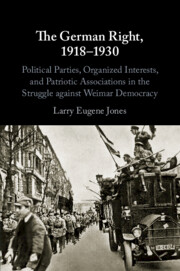 The German Right, 1918–1930
The German Right, 1918–1930 Book contents
- The German Right, 1918–1930
- The German Right, 1918–1930
- Copyright page
- Dedication
- Contents
- Figures
- Acknowledgments
- Abbreviations
- Introduction
- 1 Revolution and Realignment
- 2 Infrastructure of the German Right
- 3 Forging a Conservative Synthesis
- 4 Growth and Consolidation
- 5 The Radical Right
- 6 1923 – A Missed Opportunity?
- 7 From Triumph to Schism
- 8 Stabilization from the Right?
- 9 Paladins of the Right
- 10 A Resurgent Nationalism
- 11 The Road Back to Power
- 12 The Burden of Responsibility
- 13 From Defeat to Crisis
- 14 Reverberations and Realignment
- 15 The Chimera of Right-Wing Unity
- 16 Schism and Fragmentation
- 17 The Brüning Gambit
- 18 The September Earthquake
- Epilogue
- Select Bibliography
- Index
10 - A Resurgent Nationalism
Published online by Cambridge University Press: 21 March 2020
- The German Right, 1918–1930
- The German Right, 1918–1930
- Copyright page
- Dedication
- Contents
- Figures
- Acknowledgments
- Abbreviations
- Introduction
- 1 Revolution and Realignment
- 2 Infrastructure of the German Right
- 3 Forging a Conservative Synthesis
- 4 Growth and Consolidation
- 5 The Radical Right
- 6 1923 – A Missed Opportunity?
- 7 From Triumph to Schism
- 8 Stabilization from the Right?
- 9 Paladins of the Right
- 10 A Resurgent Nationalism
- 11 The Road Back to Power
- 12 The Burden of Responsibility
- 13 From Defeat to Crisis
- 14 Reverberations and Realignment
- 15 The Chimera of Right-Wing Unity
- 16 Schism and Fragmentation
- 17 The Brüning Gambit
- 18 The September Earthquake
- Epilogue
- Select Bibliography
- Index
Summary
Chapter 10 deals with the resurgence of nationalism on Germany’s patriotic Right in the second half of the 1920s. In many respects, this can be seen as a reaction against the increasingly prominent role that organized interests had played in Germany’s economic and political stabilization in the aftermath of Hitler’s ill-fated Beer Hall putsch. This chapter examines efforts on the part of the Ring Circle to foster a greater sense of unity within the ranks of the German Right as well as developments in the Stahlhelm, its increasing alienation from the Young German Order, and renewed activism on the part of the VVVD. All of this draws to a climax in the struggle against the Locarno Pact that Stresemann negotiated with the French, British, and Belgian governments in the spring and summer of 1925. At the epicenter of this struggle is the DNVP, which as a member of Chapter 11 covers the period from the DNVP’s resignation from the first Luther cabinet in October 1925 to its reentry into the fourth Marx cabinet in January 1927. In particular, this chapter examines the deteriorating situation in the German countryside and increased pressure from organized agriculture for the DNVP to rejoin the national government in order to protect the domestic market against agricultural imports from abroad. Industry, too, had become frustrated with the DNVP’s absence in the national government and intensified its pressure on the party for a reassessment of its coalition strategy. But the patriotic Right – and particularly the Stahlhelm, which had fallen more and more under the influence of Theodor Duesterberg and the militantly anti-Weimar elements on its right wing – strongly resisted any move that might presage the DNVP’s return to the government. Shocked by the impressive showing of middle-class splinter parties in the Saxon state elections in late October 1926, the DNVP responded to overtures from the DVP and Center to explore the possibility of reorganizing the government in January and entered into negotiations that ended with its entry into the fourth Marx cabinet in January 1927.
Keywords
- Type
- Chapter
- Information
- The German Right, 1918–1930Political Parties, Organized Interests, and Patriotic Associations in the Struggle against Weimar Democracy, pp. 299 - 330Publisher: Cambridge University PressPrint publication year: 2020
